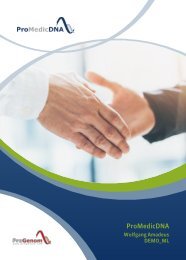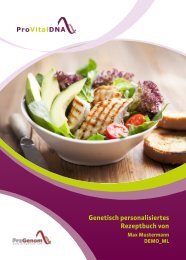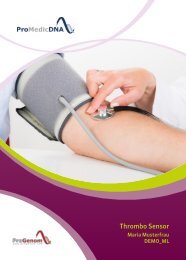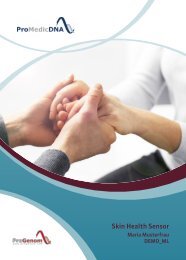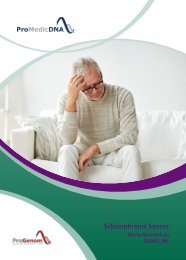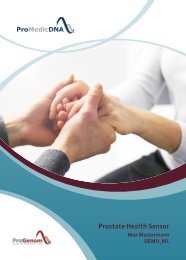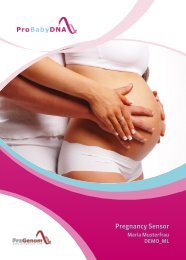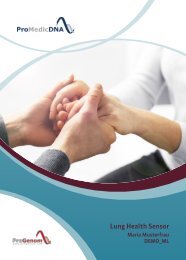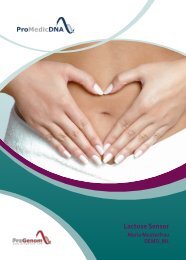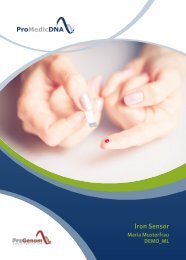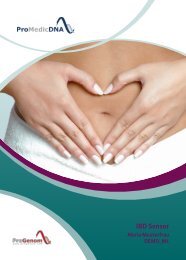ProVitalDNA - Package - DEMO EN
non-medical analysis - ProVitalDNA
non-medical analysis - ProVitalDNA
You also want an ePaper? Increase the reach of your titles
YUMPU automatically turns print PDFs into web optimized ePapers that Google loves.
FTO - Fat mass and obesity associated (rs9939609)<br />
Fat mass and excessive weight-associated protein also known as alpha-ketoglutarate-dependent dioxygenase FTO is an enzyme<br />
that in humans is encoded by the FTO gene located on chromosome 16. The amino acid sequence of the transcribed FTO protein<br />
shows high similarity with the enzyme AlkB which oxidatively demethylates DNA. Recombinant FTO protein was first discovered<br />
to catalyze demethylation of 3-methylthymine in single-stranded DNA, and 3-methyluridine in single-stranded RNA, with low<br />
efficiency. The nucleoside N6-methyladenosine, an abundant modification in RNA, was then found to be a major substrate of FTO.<br />
The FTO gene expression was also found to be significantly upregulated in the hypothalamus of rats after food deprivation and<br />
strongly negatively correlated with the expression of orexogenic galanin like peptide which is involved in the stimulation of food<br />
intake.<br />
RES Genotype POP Possible results<br />
T/T 25% No effect<br />
X T/A 57% Increased sensitivity to fat<br />
Tendency to eat more snacks<br />
Tendency to eat more calories<br />
Predisposition to excessive weight (OR: 1.34)<br />
Increased weight loss through physical activity<br />
References<br />
A/A 18% Increased sensitivity to fat<br />
Stronger feeling of hunger<br />
Tendency to eat more snacks<br />
Tendency to eat more calories<br />
Increased weight loss through exercise<br />
Predisposition to excessive weight (OR: 1.67)<br />
Am J Clin Nutr. 2009 Dec:90(6):1483-8. Epub 2009 Oct 14. The FTO gene rs9939609 obesity-risk allele and loss of control over eating. Tanofsky-Kraff M,<br />
Han JC, Anandalingam K, Shomaker LB, Columbo KM, Wolkoff LE, Kozlosky M, Elliott C, Ranzenhofer LM, Roza CA, Yanovski SZ, Yanovski JA.<br />
J Nutr. 2011 Dec:141(12):2219-25. Epub 2011 Nov 2. A High Intake of Saturated Fatty Acids Strengthens the Association between the Fat Mass and<br />
Obesity-Associated Gene and BMI. Corella D, Arnett DK, Tucker KL, Kabagambe EK, Tsai M, Parnell LD, Lai CQ, Lee YC, Warodomwichit D, Hopkins PN,<br />
Ordovas JM.<br />
Int J Obes (Lond). 2011 Aug:35(8):1041-9. doi: 10.1038/ijo.2010.263. Epub 2010 Dec 21. Association between fat intake, physical activity and mortality<br />
depending on genetic variation in FTO. Sonestedt E, Gullberg B, Ericson U, Wirfält E, Hedblad B, Orho-Melander M.<br />
Clin Chim Acta. 2010 Nov 11:411(21-22):1716-22. Epub 2010 Jul 25. Effects of common FTO gene variants associated with BMI on dietary intake and<br />
physical activity in Koreans. Lee HJ, Kim IK, Kang JH, Ahn Y, Han BG, Lee JY, Song J.<br />
Am J Clin Nutr. 2009 Nov:90(5):1418-25. Epub 2009 Sep 2. Fat and carbohydrate intake modify the association between genetic variation in the FTO<br />
genotype and obesity. Sonestedt E, Roos C, Gullberg B, Ericson U, Wirfält E, Orho-Melander M.<br />
APOA2 apolipoprotein A-II (rs5082)<br />
Apolipoproteins are the protein component of lipoproteins that transport insuluble lipids through the bloodstream.<br />
Apolipoproteins form the hydrophylic surface of lipoproteins where they fulfil various roles such as structural support or receptor<br />
sites for cell membrane bound receptors. The APOA2 gene forms a structural element and activates hepatic lipase enzymes.<br />
RES Genotype POP Possible results<br />
C/C 18% Increased fat sensitivity<br />
Increased risk for fat deposits around the organs<br />
Tendency to eat more calories<br />
Genetic predisposition to excessive weight (OR: 1.7)<br />
X T/C 43% No effect<br />
Increased risk for fat deposits around the organs<br />
References<br />
T/T 39% No effect<br />
Arch Intern Med. 2009 Nov 9:169(20):1897-906. APOA2, dietary fat, and body mass index: replication of a gene-diet interaction in 3 independent<br />
populations. Corella D, Peloso G, Arnett DK, Demissie S, Cupples LA, Tucker K, Lai CQ, Parnell LD, Coltell O, Lee YC, Ordovas JM.<br />
Int J Obes (Lond). 2011 May:35(5):666-75. Epub 2010 Oct 26. Association between the APOA2 promoter polymorphism and body weight in<br />
Mediterranean and Asian populations: replication of a gene-saturated fat interaction. Corella D, Tai ES, Sorlí JV, Chew SK, Coltell O, Sotos-Prieto M,<br />
García-Rios A, Estruch R, Ordovas JM.<br />
<strong>DEMO</strong>_ML Page 245 of 295




